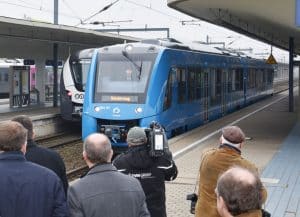
Picea 2 relies on lithium instead of lead
HPS presents new product generation
The company HPS Home Power Solutions has unveiled a new generation of its seasonal energy storage system. The Picea 2 now uses lithium batteries, which makes installation in the home easier due to the lower weight. With twice the power, the appliance is also equipped for e-mobility and heat pumps.
The new research and development site is located almost directly next to the youth center of FC Union Berlin in an industrial area in Berlin-Niederschöneweide. In the future, not only kickers but also installers and partners will be trained there. But not only that; the new version of the seasonal storage unit is also to be manufactured there. “On-site installation is even more cost-effective for us, as the transport costs come out lower,” stated company founder and CEO Zeyad Abul-Ella – left in December 2023 and since then only still a shareholder – at the first presentation of the new device to an exclusive circle of visitors.
Nine years after its founding and a good five years after the first presentation of a Picea model at the trade fair Energy Storage in Düsseldorf 2018, there is a whole series of further developments of the product. The device has needed to change with the times. With Picea 2, the output power has therefore doubled to 15 kilowatts, which makes it possible to cover higher energy requirements, for example for an e-car or a heat pump. In the event of a power failure, the backup power supply ensures that important installations in the household are supplied with a stable power supply. “For each of the three phases of the three-phase current, the device now delivers five kilowatts of power,” explained Abul-Ella.
The new generation of the storage system also offers an increased connected load for photovoltaic systems – picking up on the trend in the market. Through new power electronics, according to HPS, efficiency was able to be increased, which means that higher levels of self-sufficiency are now possible. The energy utilization efficiency (Nutzungsgrad) including heat utilization is 90 percent. The electrical efficiency is between 35 and 40 percent.
Cooperation with competent partners
The device now uses an external inverter from SofarSolar, in which the software for the storage system has accordingly been adapted. “We do what we are really good at. For all other components, we rely on cooperation with partners,” said trained civil engineer Abul-Ella. The latter applies to both the inverter and the lithium batteries.
The AEM electrolyzer comes from the German-Italian company Enapter. The abbreviation AEM stands for anion exchange membrane. The technology uses more cost-effective materials such as steel instead of titanium and combines the advantages of alkaline electrolysis with the flexibility and compactness of PEM electrolysis. Enapter co-founder Vaitea Cowan was also present at the product launch, and Hans-Peter Villis, former EnBW (Energie Baden-Württemberg AG) director as well as partner from the very beginning and today chairman of the supervisory board at HPS.
Specifications for developers
“A tough requirement for the technical developers was to retain the dimensions for the slide-in boxes for the electrolyzer and the fuel cell in the energy center of the original Picea,” stressed Abul-Ella. The first Picea customers are pioneers. They should therefore also benefit from the innovations and be able to switch to them easily at a later date. A further development in the electrolysis module cools the hydrogen to 5 °C. This makes it possible to take in four to five times the amount of gas, because the moisture is now removed before storage.
New are also status displays that, at the touch of a button on the device or via the app, provide information about important system and storage statuses. The system always consists of an energy center and a hydrogen storage tank with a compressor that is installed outside the house on a concrete foundation. This foundation is absolutely essential.
The energy center unit has slimmed down considerably and now weighs 70 percent less: instead of 2.2 metric tons, now only 700 kilograms (1540 lbs). Reason is the switch from lead-acid to lithium batteries from the company Pylontech. The overall height has also reduced by 15 centimeters compared to its predecessor to 1.85 meters (6.07 ft). Doesn’t sound like much, but can be decisive for installation in a basement.
The Picea 2 costs at minimum 99,900 euros
The Picea module converts the surplus solar power in summer into hydrogen. In this way, large amounts of energy can be stored efficiently and over long periods of time. In winter, the gas, via a fuel cell, can be converted back into electricity and heat. The long-term storage capacity is up to 1,500 kilowatt-hours of electricity. In the smallest version with 16 gas cylinders, it is 300 kilowatt-hours.
The smallest version of the Picea 2 costs 99,900 euros. The gross price is the same as the net price, as the sales tax for the device, including storage units, is zero percent. With more storage capacity, the cost rises to up to 140,000 euros. This applies to a new construction where the installation can also be planned. In existing buildings, it can be a bit more complicated, so the amount may increase to up to 160,000 euros.
The demand seems to be there. Because over 500 devices of the first generation have been sold to date. More than 100 are installed at customers’ spaces.
Author: Niels Hendrik Petersen







